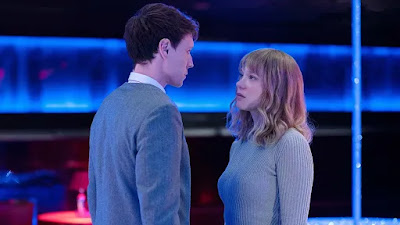So Bonello flashes ahead to 2044, with a boxier frame that signifies limited horizons, and to an affectless world overrun by AI programmed to remove fear - among other emotions - from the equation. "Disasters lie in the past," one such computer informs Seydoux's troubled seeker, while making passing reference to "the tragedies of 2025" - a phrase guaranteed to set the overthinkers among us on edge. So many things could go wrong, from a 2020s perspective - and there, to some degree, is the existential terror James caught back in his day: those elements beyond our immediate control, the elephants in the room, the spectre in the corner of the eye. The process the Seydoux character undergoes to correct this, namely being medically purged of those emotions that make her uniquely human, hardly makes her life any easier; and if you were wondering how many ways a filmmaker can make this actress suffer, wait until the halfway mark, where we find ourselves in the L.A. of 2014, witnessing a collision between Seydoux's fashion model and Mackay's incel, purveyor of insufferable, self-pitying vlogs. It's around this point that The Beast comes to feel aggressively, even numbingly talky, although that talk serves Bonello's unifying themes: that every generation has its own insecurities, that fear, as much as love, is what binds us to our forefathers. That's why we keep turning back to James and his ilk: as a coping strategy almost, to see how they handled their demons, and where they didn't or couldn't.
Bonello's imagemaking is never in question: again here, he punctures architectural good taste (lots of lavishly furnished modernist abodes) with potent, oft-discomfiting symbols (sharp knives, dolls of various kinds). Even more striking is his narrative facility and fluidity: the film flows into and out of these three realities, each as plausible as the next, each offering a running commentary on what's around it. Is the period stuff a fantasy Seydoux's character has after being neutralised in the future? Or are the latter-day scenes a vision she has after submitting to a hypnotist's instruction? The director is smart indeed about deploying his name actors as fixed points and saleable features. Even as the drama veers towards the sedentary, both Seydoux and Mackay operate in subtly variegated modes, suggesting a world shifting under our gaze even before Bonello begins messing with the plasticity of the image. For a while, everything fits together in the same uncanny fashion as, say, the shards of Meshes of the Afternoon; an ominous mood is created. (The coda is pure Twin Peaks fan fiction.) But is the movie anything more than a mood, or just bad vibes only for an exhausting 146 minutes? The question has hovered over previous Bonello features; here, it all but crowds out the light in these frames, like an especially pregnant raincloud. The Beast struck me as so unyieldingly po-faced and self-involved (common translation: "up itself") that it's bound to be dismissed as pretentious by a percentage of those drawn here by the glowing reviews; it's adaptation as undertaken in some polished, sterile artfilm laboratory where lofty theory goes uncontaminated by anything so down-and-dirty as reality. But I'll give Bonello this: if you have known doubt, and if you've felt uncertainty, it may be a harder film than most to shake off so easily.
The Beast is now available to rent via Prime Video, Curzon Home Cinema, the BFI Player and YouTube; it becomes available to stream on MUBI from July 19.

No comments:
Post a Comment